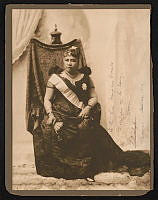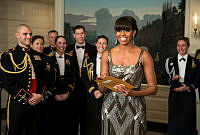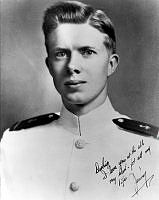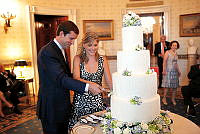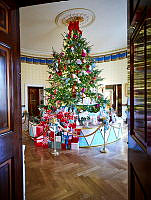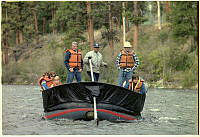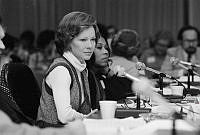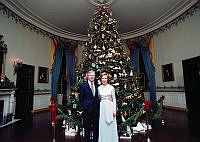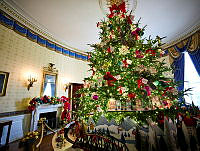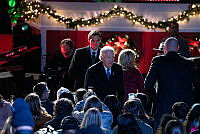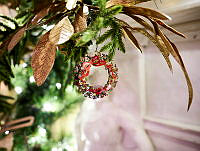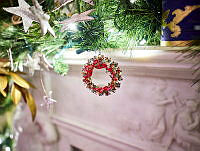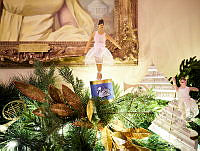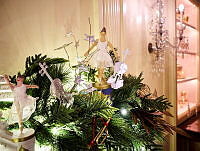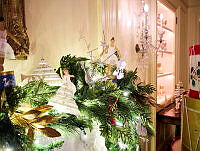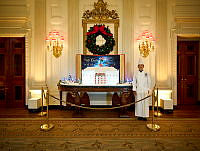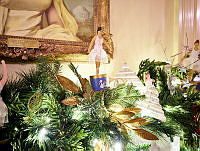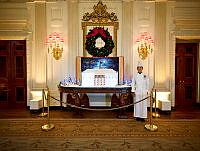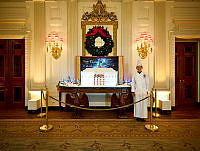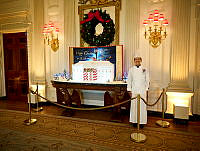Rubenstein Center Scholarship
"The Touch of Velvet and the Stamina of Steel"
Lady Bird Johnson in the White House

Lady Bird Johnson at work in the White House.
LBJ Presidential LibraryOn November 22, 1963, tragedy brought Claudia “Lady Bird” Johnson to the White House and thrust her into the national spotlight. Following the assassination of President John F. Kennedy in Dallas, Texas, her husband Lyndon B. Johnson took the Oath of Office aboard Air Force One at Love Field. In the blink of an eye, Lady Bird Johnson became the first lady—a title she neither expected nor coveted. Nevertheless, she stepped into the role of first lady with grace and fortitude.
Claudia Alta Taylor was born in Karnack, Texas in 1912. She received her famous nickname “Lady Bird” from her nurse, an African-American woman named Alice Tittle.1 As a young woman brought up in the American South, she was taught and expected to demonstrate charm, warmth, and civility. After studying history and journalism at the University of Texas, she married Lyndon Baines Johnson, a young politician-in-training who would eventually climb from the House of Representatives to the United States Senate, and finally, to the vice-presidency and presidency. Lady Bird Johnson was not altogether unprepared for the role of first lady. After decades of experience as the wife of a congressman, Mrs. Johnson was politically savvy and independent—but she never forgot her southern roots. A friend once recollected that Lady Bird had “the touch of velvet and the stamina of steel,” traits that served her well during her time in the White House.2

In 1965, Lady Bird became the first first lady to hold the Bible upon which the president was sworn in.
LBJ Presidential LibraryAdditionally, the relationship between Lyndon B. Johnson and Lady Bird Johnson was more than a marriage—it was a political partnership. While advising her husband on foreign affairs and domestic crises, Mrs. Johnson maintained her calm, steadfast demeanor—the perfect foil to President Lyndon B. Johnson’s forceful personality. In fact, at Johnson’s 1965 Inauguration, Lady Bird became the first first lady to hold the Bible upon which the president was sworn in.3 By performing this act, Lady Bird Johnson began a tradition that epitomized her influential work in the White House, and her participation reflected both the Johnsons’ close partnership and the increased visibility and authority of the role of first lady.
While Lyndon Johnson sought to address civil rights, poverty, and racial inequality early on in his presidency, Lady Bird quietly guided him, providing advice on policy and feedback on speeches, all while working on her own projects. One of these major contributions was Lady Bird’s whistle-stop campaign ahead of the 1964 election. President Johnson was losing voters across the American South because of his support and signing of the Civil Rights Act on July 2, 1964. Lady Bird Johnson took it upon herself to travel across the region in a train nicknamed the “Lady Bird Special,” rallying much-needed votes and praising her husband’s civil rights agenda.4 Lady Bird, accompanied by her daughters Lynda and Luci, campaign staff, and reporters, boarded the train on October 6, 1964, riding through the South and addressing crowds from the train’s caboose.5 They traveled 1,682 miles in only four days’ time, and received threats and faced hostile crowds in pursuit of four more years in the White House. In fact, White House Press Secretary Bill Moyers later recollected:
"The air [had] become so menacing, we [ran] a separate engine fifteen minutes ahead of her in case of a bomb…Rumors spread of snipers, and in the Panhandle of Florida the threats [were] so ominous the FBI [ordered] a yard-by-yard sweep of a seven-mile bridge that her train would cross."6

Mrs. Johnson aboard the "Lady Bird Special" in 1964
Lyndon B. Johnson Presidential Library and Museum/NARANever one to back down in the face of adversity, Lady Bird kept going, reminding spectators: “I wanted to make this trip because I am proud of the South and I am proud that I am part of the South.”7 White House Social Secretary Bess Abell later recalled: “Mrs. Johnson’s drawl grew thicker the deeper south they went.”8 In the end, Lady Bird was successful in her mission. Lyndon Johnson won the 1964 election in a landslide, and Lady Bird made history as the first first lady to campaign without her husband at her side.9
She also bolstered major policy platforms during her husband’s administration. To support Johnson’s War on Poverty, Lady Bird Johnson championed Head Start, a program supporting the development and education of impoverished children across America.10 The first lady visited classrooms, met with children and educators, and spoke on behalf of her husband about the benefits of the program. She also traveled to impoverished towns and neighborhoods in Appalachia, including Kentucky, North Carolina, Pennsylvania and Tennessee, assessing living conditions and speaking to locals.11

Lady Bird Johnson at the White House unveiling of the Head Start program, 1965.
White House Historical AssociationLike her predecessor Jacqueline Kennedy, Mrs. Johnson was passionate about the historic White House, the arts, and beautification, and sometimes these interests directly overlapped. In the summer of 1965, Mrs. Johnson worked with the National Gallery of Art to unveil an exhibit of contemporary American art at the White House, called the White House Festival of the Arts. Actors, musicians, and writers attended the festival including Gene Kelly, Duke Ellington, and Marian Anderson.12 Contemporary sculptures dotted the White House Grounds, paintings hung inside the Executive Mansion, and singers, musicians, and poets entertained guests over a buffet lunch.13
Mrs. Johnson also enhanced indoor and outdoor spaces at the White House. In April 1965, she renamed the recently renovated East Garden the “Jacqueline Kennedy Garden” in honor of the former first lady’s efforts to restore the White House.14 In fact, Lady Bird Johnson institutionalized many of her predecessor’s White House preservation efforts. Executive Order 11145, signed by President Johnson on March 7, 1964, officially established the position of White House Curator and the Committee for the Preservation of the White House, both of which work to preserve and protect the historic rooms and furnishings in the Executive Mansion.15 The White House Historical Association also commissioned and funded portraits of Lady Bird and Lyndon Johnson during their tenure in the Executive Mansion—a precedent that most presidents and first ladies have followed since.16 Lady Bird also spearheaded the creation of the Children’s Garden on the South Lawn, where presidential grandchildren leave their handprints or footprints. The first prints were left by her two young grandchildren, Patrick and Lucinda, and it was dedicated shortly before the Johnsons left the White House.17

Lady Bird Johnson at the White House Festival of the Arts, 1965.
White House Historical AssociationAbove all, Lady Bird Johnson advocated for nationwide beautification— her signature cause while serving as first lady. In 1965, Mrs. Johnson oversaw local efforts to expand green spaces, plant trees and wildflowers, clean up shorelines, and remove litter after convening the Committee for a More Beautiful Capital at the White House.18 Lady Bird Johnson often participated in planting flowers and trees herself, remarking: “When I go into the poorest neighborhoods, I look for the flash of color - a geranium in a coffee can, a window box set against the scaling side of a tenement, a border of roses struggling in a tiny patch of open ground. Where flowers bloom, so does hope.”19

President Johnson hands Lady Bird Johnson a pen used to sign the Highway Beautification Act, 1965
LBJ Presidential LibraryShe then turned her attention to the nation as a whole, advocating for the Highway Beautification Act of 1965. The act, which provided for the introduction of new plant life and the regulation of billboards along the Interstate Highway System, was nicknamed “Lady Bird’s Bill.”20 Thanks to her, environmentalism was a major priority for the Lyndon B. Johnson administration, which supported the passage of nearly 200 laws related to the environment, including the preservation and formation of national parks and legislation protecting water, wildlife, and trees.21 Her lifelong love of wildflowers is evident in the Johnson State Service, which features hand-painted state flowers.

Mrs. Johnson is pictured recording her audio diary in the White House
LBJ Presidential LibraryLady Bird’s daily diary is an invaluable source when studying the Johnson White House, as it chronicles her initiatives, feelings, and opinions in her own words. She recorded 123 hours of audio footage as well, narrating many of these experiences during the Johnson administration.22 These sources reveal that Lady Bird Johnson was influential in her husband’s decision not to run for re-election in 1968, choosing to instead retire from politics and return to Texas.23 After experiencing and documenting the many highs and lows of life in the Executive Mansion, Mrs. Johnson reflected: “I have loved almost every day of these five years.”24
Lady Bird Johnson remained active in the public realm throughout the rest of her life. She worked diligently on the creation of the Lyndon B. Johnson Presidential Library in Austin, Texas and published her daily diary, A White House Diary, in 1970. After Lyndon B. Johnson passed away on January 22, 1973, Lady Bird worked to preserve his legacy with honesty and integrity. She approved the release of secret Oval Office recordings, for example, risking the content of the tapes in order to preserve and share the history of the Johnson administration.25 Mrs. Johnson also continued her environmental advocacy and joined other first ladies including Betty Ford and Rosalynn Carter in supporting women’s equality.26
In 1977, President Gerald R. Ford awarded Lady Bird Johnson the Presidential Medal of Freedom at the White House. The citation read:
As one of America's great first ladies, she claimed her own place in the hearts and history of the American people. In councils of power or in homes of the poor, she made government human with her unique compassion and her grace, warmth and wisdom. Her leadership transformed the American landscape and preserved its natural beauty as a national treasure.27
Lady Bird Johnson died on July 11, 2007 at age 94.

Lady Bird Johnson sits among the Texas wildflowers in 1990.
LBJ Presidential Library




